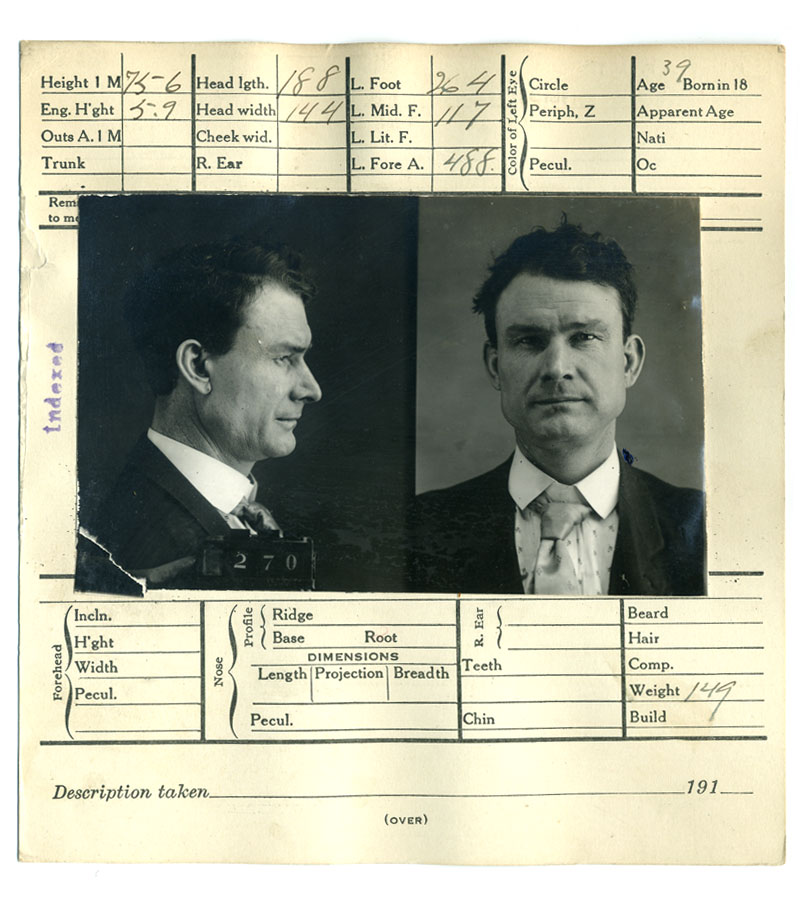
POMO Galerie
via Giuseppe Sirtori, 6 — 20129 Milano

SAFE DISTANCE
TRUE LENS
Curated by Fabrizio UrettiniÂ
17.10.2014 — 09.11.2014Â
OPENING Thursday 16th OCTOBER 2014 — 18.30
17.10.2014 — 09.11.2014Â
OPENING Thursday 16th OCTOBER 2014 — 18.30
Pomo Galerie and Fabrizio Urettini have the pleasure to present “Safe distanceâ€, a selection of american mugshots taken over fifty years between 1890 and the 40s of the XX century. “Safe distance†is the first project of “True Lens†festival which is dedicated to criminal photography. Identifing, registering, classifing, filing. The images in this collection were all created to satisfy simple, fundamental and “mechanical†operations of surveillance and law enforcement required by our society’s obsessive bureaucracy.
“Photography represented (...) a way of collecting prototypes of an increasingly complex world that needed a consistent, acknowledged and comprehensible classification.â€Â 1Â
Using mugshots for judicial purposes (a genre that is often ignored by official history books), took place immediately after the art of photography came into being. It is almost as if the initial urge to point a camera at someone’s face coincided with the impulse to seize it, possess its image and lock it away in a jail, an asylum or an archive.Â
The idea of “capturing†a criminal acquiring its image had a very precise meaning in the mid nineteenth century, the period in which the first mugshots were taken.Â
“In the wake of industrial revolution, when the “masses†made their disquieting emergence in the bourgeois consciousness, the need to gain control over a vast and chaotic society suggested the idea of judicial photography.â€Â 2Â
The camera therefore became a measuring instrument, adopted by the newborn discipline of psychiatry to diagnose mental illness. From there, thanks to the positivist formula of mad=delinquent, it passed, almost immediately, into the hands of the criminal anthropologists who were eager to find proof of human delinquent tendencies in facial measurements, expressions, scars or other deformities.Â
Before becoming an investigative instrument (or simply a precautionary tool), mugshot photography was a clinical discipline, a system for measuring and classifying human delinquency. Perhaps it is because of these origins that, even if on one hand judicial photography seems to be the lowest expression of photography, being neutral, pragmatic and impersonal (photography without the photographer), on the other, it is deeply complex, problematic and deeply layered.Â
“The mugshots are precious iconographic sources for a public representation of Evil.â€Â 3Â
This exhibition of portraits of true or supposed-to-be criminals and their crimes has been ideated to stimulate some thoughts on what we expect from photography. We are inclined to accept what photography presents instead of questioning the photographic images, reflect on the author behind the shots and the culture that has produced them.Â
Scientific Committee: Andrew Moseley, Matteo Segna, Andrea Staid, Fabrizio Urettini.Â
The exhibition is accompanied by the contributes of the author of “I dannati della metropolis†Andrea Staid and the emergent british curator Andrew Moseley.Â
Fabrizio Urettini graphic designer and art director born in Treviso. His field of research goes from the ideation of corporate identity for public and private firms to the curatorship and communication for cultural events and expos.Â
Founder of “Spazio XYZ†(2008-2012), a plural exhibition space devoted to the different expressive forms of applied arts, has over 40 expo projects developed through collaborations with important international designers, illustrators and photographers.Â
The only Italian space covered by Art Spaces (New Museum - New York). He has collaborated with several important institutions such as the Italian Ministry of Foreign Affairs, IUAV University, Fondazione Benetton, Werkbund Archive, Fondazione Corrente and the Milano City Council.Â
Since 2008 he has been collaborating with Fototeca Gilardi for the realization of the first anthology of Ando Gilardi. Since 2011 he is the artistic director of the children books series Biancopanna.